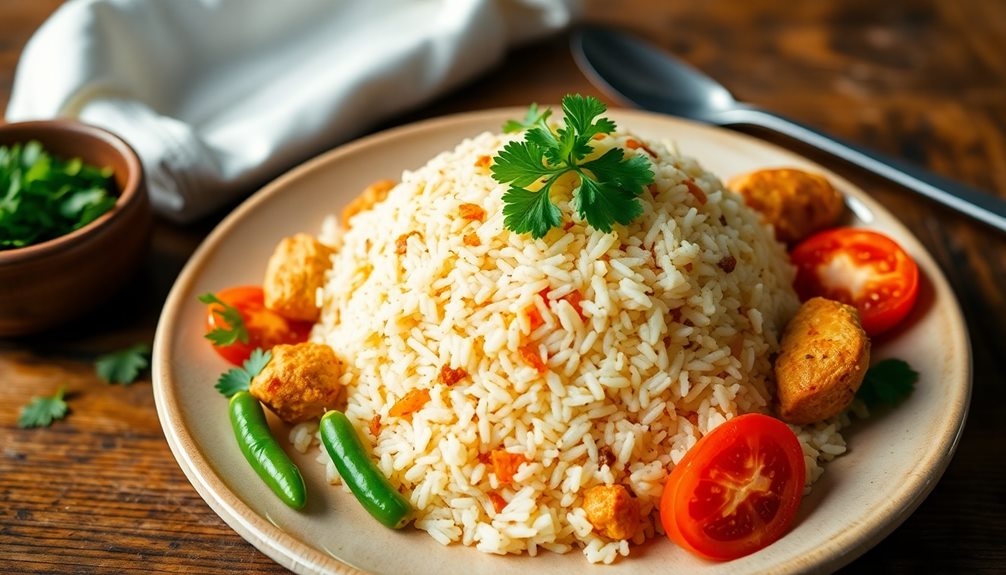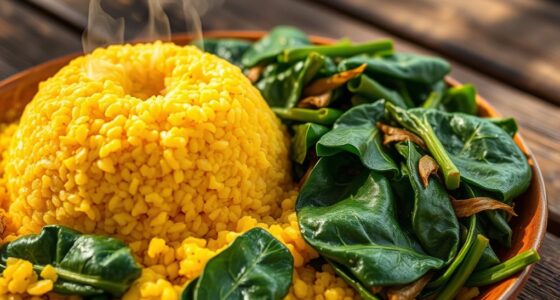To get that authentic Kenyan nyama choma flavor, choosing the right wood is key. Hardwoods like mesquite, acacia, or hickory burn slowly and produce fragrant smoke that enhances the meat’s natural taste. Avoid softwoods like pine, which can add resinous, unwanted flavors. The wood’s choice impacts the smoky aroma and flavor depth, making your choma more mouthwatering. Keep exploring to discover how selecting the perfect wood can elevate your nyama choma experience.
Key Takeaways
- Hardwoods like mesquite, acacia, and hickory produce fragrant, slow-burning smoke that enhances nyama choma’s flavor.
- Softwoods such as pine or cedar burn faster and can introduce resinous, undesirable flavors to the meat.
- The type of wood influences the intensity and aroma of the smoky flavor, shaping the overall taste profile.
- Proper wood selection ensures consistent smoky flavor while supporting sustainable and traditional cooking methods.
- The choice of wood reflects cultural practices, emphasizing authenticity and the social significance of nyama choma.

When it comes to making perfect nyama choma, choosing the right type of wood can make all the difference in flavor. The smoky aroma and rich taste of well-cooked nyama choma hinge on the kind of wood you use. The smoky flavor is also influenced by the natural materials used during the burning process, which can add unique character to the meat. Different woods produce varying levels of smoke, which in turn influences the meat’s flavor profile. Hardwoods like mesquite, acacia, or hickory are popular because they burn slowly and emit a strong, fragrant smoke that enhances the meat’s natural flavors. Softwoods, such as pine or cedar, burn faster and can introduce unwanted resinous flavors, so they’re best avoided. Your choice of wood is not just about taste—it’s about creating an experience that resonates with Kenya’s vibrant food traditions. Utilizing proper wood selection can also help in maintaining consistent smoky flavors across different barbecues.
In Kenyan culture, nyama choma is more than just a meal; it’s a social event often accompanied by lively gatherings that celebrate community and heritage. When hosting a nyama choma barbecue, the setting can reflect traditional customs, with guests dressed in traditional attire that highlights cultural pride. Wearing shukas or kikoys, for example, adds a sense of authenticity and respect for longstanding customs. These garments, often colorful and patterned, emphasize the importance of tradition in Kenyan society. Just as traditional attire reflects cultural identity, the choice of wood echoes historical methods of preparing and enjoying meat. It’s a way to honor the past while sharing a meal that brings people together.
Your selection of wood can also influence the overall atmosphere of the gathering. The aroma of smoked meat, infused with the right kind of wood, can evoke memories of family celebrations, weddings, or community festivals. These events often feature marriage customs such as the exchange of blessings and traditional dances, all accompanied by the aroma of nyama choma. The smoky flavor symbolizes unity and shared heritage, making the meal more meaningful. The way you prepare the meat—marinated with local spices or served simply—complements the smoky undertones imparted by the wood. It’s a reminder that every detail, from traditional attire to the choice of wood, plays a role in creating an authentic experience rooted in Kenyan culture.
Additionally, choosing the right wood can be aligned with sustainable practices, ensuring that traditional methods do not harm the environment while still delivering exceptional flavor. The smoky flavor symbolizes unity and shared heritage, making the meal more meaningful. The way you prepare the meat—marinated with local spices or served simply—complements the smoky undertones imparted by the wood. It’s a reminder that every detail, from traditional attire to the choice of wood, plays a role in creating an authentic experience rooted in Kenyan culture.
In the end, selecting the right wood isn’t just about flavor; it’s about celebrating tradition. It’s about connecting with history, community, and cultural customs that have been passed down through generations. When you opt for the right hardwood, you’re not only elevating the taste of your nyama choma but also honoring the rich cultural tapestry that makes Kenyan cuisine so unique. Your barbecue becomes more than a meal—it becomes a story told through flavor, tradition, and shared experience.
Frequently Asked Questions
What Are Traditional Kenyan Woods Used for Nyama Choma?
When preparing nyama choma, you use traditional Kenyan woods like Maasai firewood and indigenous tree species. These woods are favored because they burn hot and produce a rich, smoky flavor that enhances the meat. As you choose your wood, consider those native to Kenya, such as acacia or mbaazi. Using traditional woods not only adds authentic flavor but also connects you to local culinary customs, making your nyama choma truly special.
How Does Humidity Impact the Wood Burning Process?
Humidity effects your wood burning process by influencing how easily the wood ignites and burns steadily. High humidity can make the wood damp, leading to inconsistent flames and more smoke, which impacts smoke consistency. You might notice more crackling and uneven heat, making it harder to control the smoky flavor. To guarantee a steady burn and ideal smoky flavor, store your wood in a dry place and avoid humid conditions.
Can Artificial Flavors Enhance the Smoky Taste?
Your craving for that perfect smoky flavor can feel like chasing a mythical beast, but artificial flavors might help. They can enhance smoke flavor enhancement, giving your meat a richer, more intense smokiness. Rest assured, when used properly, artificial flavor safety remains high, making them a reliable shortcut. Just be cautious and use them in moderation to avoid overpowering natural tastes, ensuring your dish stays authentic and delicious.
Which Wood Types Are Best for Different Cuts of Meat?
When choosing wood types for grilling, you want to take into account meat-specific woods to enhance flavors. For beef, hardwoods like oak or hickory work best, providing a strong smoky taste. For chicken or pork, fruit woods like apple or cherry add a sweet aroma. Avoid softwoods, which can produce unpleasant flavors. Using the right types of wood ensures your meat develops a rich, balanced smoky flavor, elevating your grilling game.
How Long Should Wood Be Seasoned Before Use?
Did you know that properly seasoned wood can improve your smoky flavor by up to 50%? You should store your wood in a dry, ventilated area for at least 6 to 12 months to allow proper seasoning duration. This process reduces moisture, leading to cleaner flames and richer smoke. Proper wood storage and seasoning are key to achieving that perfect, flavorful smoky taste every time you cook.
Conclusion
Choosing the right wood can transform your nyama choma from good to unforgettable, with a smoky flavor that keeps everyone asking for more. Did you know that using fruit woods like mango or apple can reduce cooking time by up to 20%? So, next time you’re preparing nyama choma, experiment with different woods—you might discover a new favorite! Elevate your grilling game and impress friends with flavors that are truly unforgettable.









